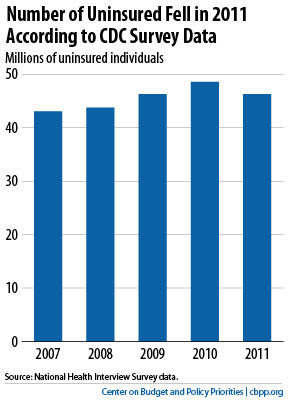BEYOND THE NUMBERS
The Census Bureau on Wednesday will release estimates of the number of Americans with and without health insurance coverage in 2011, based on its annual Current Population Survey. We’ve issued a brief report on what to look for in the data.
The good news: preliminary data from the Centers for Disease Control and Prevention (CDC) indicate that in 2011, the total number of uninsured Americans fell for the first time in four years. Less promising: private health coverage among adults from 26 to 64 years old continued to fall, marking the fourth consecutive yearly decline in the coverage rate for this group, though major provisions of health reform scheduled for implementation in 2014 are designed to reverse this erosion of private coverage.
Four key developments that the data will likely show:
- The number of uninsured fell substantially in 2011, but it remains much higher than before the recent recession. CDC data indicate that the number of Americans without health insurance coverage fell last year by 2.3 million people to 46.3 million uninsured Americans (see chart). Those gains didn’t erase the losses of the recession, though; in 2011, according to the CDC data, 3.2 million more Americans were uninsured than in 2007.
- Health reform expanded coverage for young adults. Among adults aged 19 through 25, 56.2 percent had private insurance coverage in 2011 — 5.2 percentage points more than in 2010. A provision in health reform that allows adult children to obtain coverage through their parents’ health insurance plans up to their 26th birthday is likely the overwhelming reason why.
- The erosion of private coverage continued. While private insurance coverage rates for non-elderly adults overall remained stable for the first time since 2007, at 64.2 percent, this masked a continued deterioration of private coverage among those not affected by the health reform provision for young adults. Among people aged 26 through 64, the private coverage rate fell by 0.8 percentage points in 2011, according to the CDC data.
- Medicaid and the Children’s Health Insurance Program (CHIP) have remained an increasing source of coverage for children and adults. The percentage of children under age 18 with publicly funded health insurance coverage rose by 1.2 percentage points in 2011, to 41 percent. This increased enrollment likely resulted, in part, from a federal requirement that states maintain their eligibility rules and procedures for Medicaid and CHIP. The percentage of children who are uninsured has been cut in half since the CDC began collecting these data in 1997, despite continued erosion in private insurance coverage.

Click here for the full paper, and check the Center’s website on Wednesday for further analysis of the Census data.
